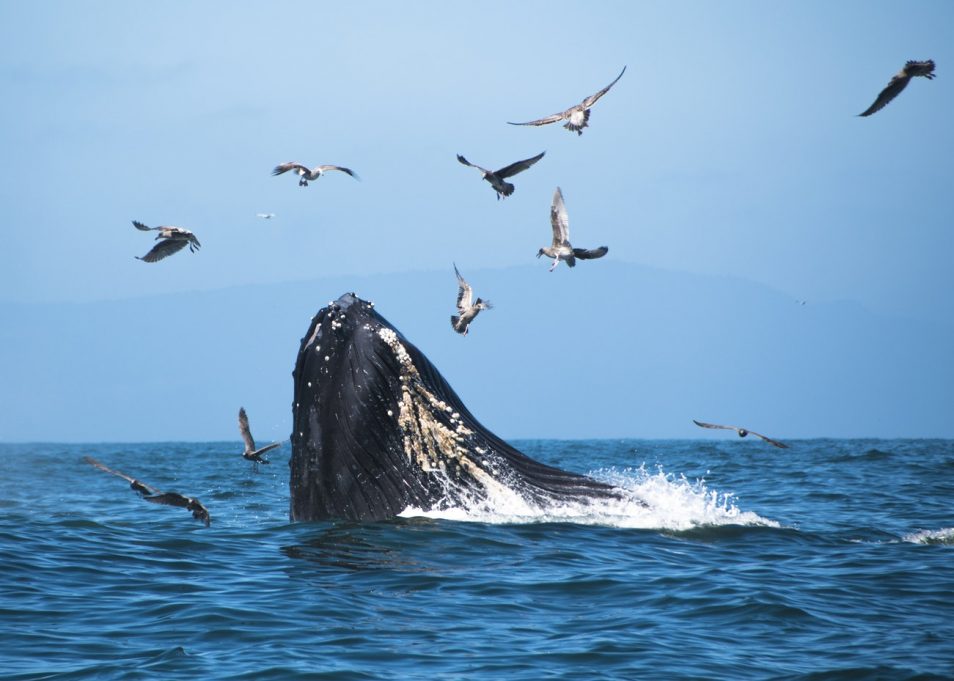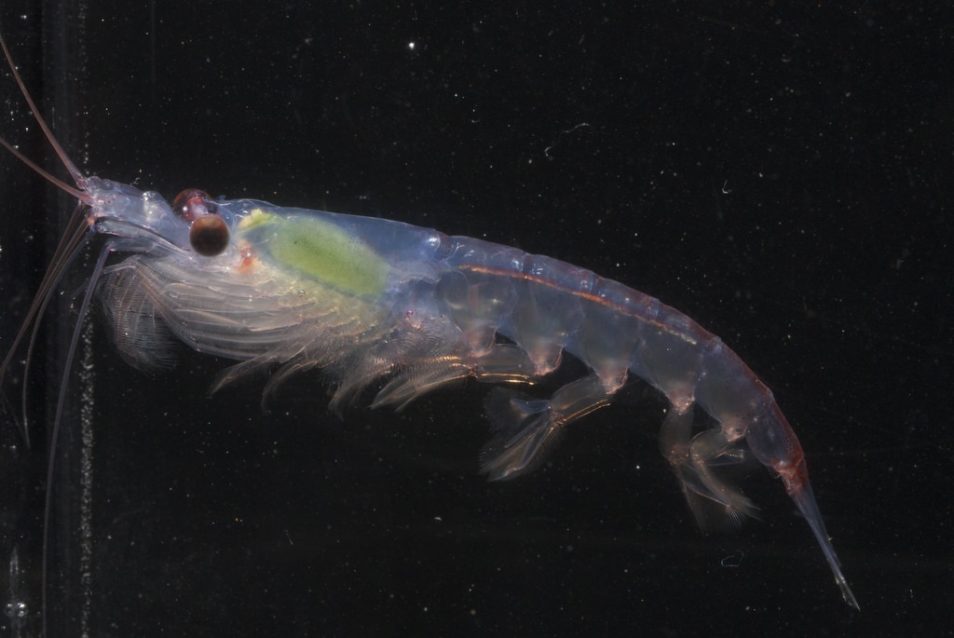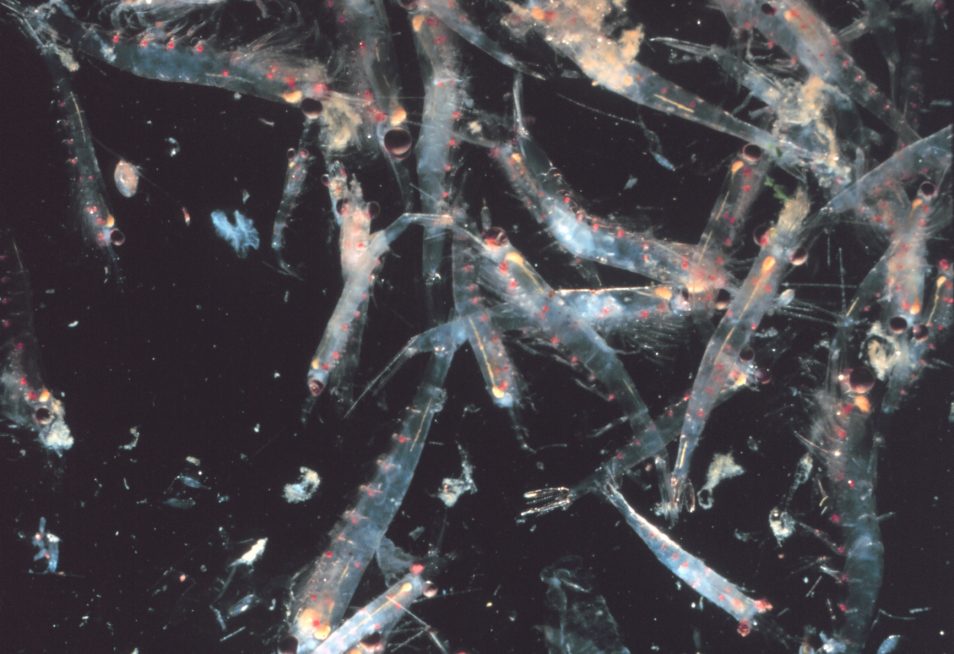
Whales love krill. One adult whale can eat up to 3 tonnes of krill in one day. But how will climate change affect krill numbers? Image: Humberto Braojos
Krill, krill, delicious krill
Baleen whales eat a lot of krill. And because krill are found in swarms, this allows whales to consume large quantities to sustain them. One adult blue whale can eat up to 4 million krill — that’s more than 3 tonnes! — in just one day. That’s a lot of krill!
Over the last century, historical whaling pushed many whale species close to extinction. Estimates indicate that whale numbers in the Southern Hemisphere are slowly recovering, but many populations are still far below their pre-whaling numbers.
We want to understand the pressures on whale recovery in the future. So our researchers have been investigating the influence of climate change on krill levels in southern oceans. We want to know how climate change could affect whale populations — including Blue, Minke, Humpback and Fin whales — across the Southern Hemisphere.
Dr Viv Tulloch led the new study for CSIRO and University of Queensland. She says this is the first time climate change has been linked to future whale populations in the Southern Hemisphere.

Krill are shrimp-like crustaceans. One krill may be roughly 5 cm long, but together they form a giant link in the global food chain. Image: Beth Simmons
Krill for their fill
Krill is the main prey for baleen whales. So we looked at how changes in the marine environment, such as changes in ocean temperatures, primary productivity and sea-ice, could affect krill biomass and whale populations in the Southern Hemisphere.
“A rise in water temperature will likely impact krill numbers, as they are well adapted to cooler Antarctic waters,” explains Dr Tulloch. “This could have a knock-on effect on whale populations. Whales form the higher trophic levels of the marine food web and rely on lower level trophic species, like krill, to survive. In other words, whales may have to compete for food because of changes to the ocean environment and the amount of krill available for whales to eat.”
“The impacts on whale species could differ, depending on the region, where they feed and their current levels of recovery from historical whaling. For example, whale populations in the southern Pacific Ocean were heavily harvested last century, so those whales could have less krill to feed on in the future compared to those in the Atlantic and Indian Oceans.”
The results are based on high emissions climate trajectories using a CSIRO oceans-climate model linked to a Model of Intermediate Complexity for Ecosystem Assessments, known as MICE. The advanced modelling tool used a range of to generate whale population predictions to the end of the century.
“Using MICE enabled us to connect the life history of whale species in the Southern Hemisphere with food availability and how climate drivers could determine population numbers in the future,” says Dr Tulloch.

A swarm of krill. With climate change, scientists estimate that there may be less krill in the Pacific Ocean in the future. Image: Jamie Hall from US NOAA.
Temperature changes, behaviour changes
Baleen whales in the Southern Hemisphere rely on stable environmental conditions. They use the energy from prey found in polar waters to travel long distances to their nursery grounds in warmer waters, to then travel to feeding grounds in the Antarctic, where prey is easily found. Dr Tulloch says that their slow population growth rates and dependency on krill make baleen whales sensitive to changes in the marine environment. But her research also explored other scenarios that could see whale recovery continue.
So how do we estimate krill abundance and whale recovery, in our Southern Hemisphere? First we need to understand future carbon emissions and how this impacts the ocean, by rising ocean temperatures, for instance.
“It might also mean that whale populations will need to adapt to changing environmental conditions and prey distributions,” says Dr Tulloch. “As ocean temperatures increase and sea ice decreases, whales may have to travel greater distances for prey. This means that their migration behavior may change. We could see recovery outcomes improve for some species, such as blue whales, as they are not as dependent on krill in the warmer regions where krill declines are predicted.”
Paving the way for whale recovery
Aside from climate change, whales face other pressures too, such as becoming bycatch, getting entangled in nets (especially for Southern Right and Humpback whales) and shipstrike. However, the recovery of baleen whales in the past few decades has been shown to be on a positive trend and Dr Tulloch hopes the conservation efforts for recovery continues.
“Southern Rights were heavily harvested and were reported to reach just 300 globally before anti-whaling laws were established,” explains Dr Tulloch. “On average, they raise one calf every three to five years, which means they are slower to recover from population impacts than some of the other species like humpback whales which raise a calf on average every two years.”
This new research fills an important knowledge gap concerning baleen whales and how they might respond to a changing climate in the future. Managing krill abundance and future emissions could help ensure populations continue to recover.

The research into krill and climate change fills an important gap in our knowledge of ongoing whale recovery. Image: NOAA Photo Library


7th March 2019 at 11:02 am
Is there any information on how much small plankton is also part of their diet?
Would like some contacts who might be able to provide answers.
12th March 2019 at 12:59 pm
Hi Ken,
Krill are the primary food source for many filter-feeding species of whales that inhabit the Antarctic, including the blue, humpback, and minke whale. Smaller plankton, however, are a major food source for some baleen whales. Southern right whales survive on a combination of phytoplankton and zooplankton, including smaller copepod species, and are less reliant on krill as a food source than some other baleen whale species. Our model accounts for the different prey preferences of each of the five baleen whale species studied.
Cheers,
Kashmi
CSIRO Social Media Team
7th March 2019 at 10:19 am
Will the nations that are “harvesting” krill for stock feed and fertilizer stop their activities?
12th March 2019 at 1:02 pm
Hi Peter,
Our research looks specifically at linking climate change to krill levels and how this will affect future whale populations in the Southern Hemisphere. We used modelling based on high climate predictions to provide these insights. Managing emissions and krill harvesting could possibly help to mitigate impacts on whales.
Cheers,
Kashmi
CSIRO Social Media Team
7th March 2019 at 10:16 am
The climate has changed drastically from time to time over the past 10,000 years at least and got back to normal. The animals, birds and sea creatures have adapted well. When we look at a sliver of time (a tiny slice) we can panic: and that is what we are all doing. Rest assured that nature is more adaptable to changes than the thinking of humans. Yes humans can kill off the whales by our stupidity and greed but leave the climate to nature. We will not make even a minute impact on climate by our actions. Just look at the sun activity, the volcanoes, forest fires, etc. these have a profound effect. But man cannot change it. Drop the climate change nonsense and let us focus on pollution (man made) of the waters, landfills, etc. and on our greed and waste.
7th March 2019 at 10:11 am
It will depend on which way the climate goes. If it warms, there should be an increase in Krill, if it cools a decrease. Luckily, temperatures in the sea change more slowly.
12th March 2019 at 3:01 pm
Hi Alex,
Krill are actually adapted to cold Antarctic waters, so in the mid-latitudes where temperatures are expected to warm in the future beyond the threshold for krill survival (4 degrees C), krill numbers will likely decline. Colder waters are more suitable for their survival than warmer waters.
Cheers,
Kashmi
CSIRO Social Media Team
7th March 2019 at 10:00 am
I was wondering just what effects the recent sale of Krill Oil as a supplement has on the Whales food chain?
12th March 2019 at 1:03 pm
Hi Jan,
This research links climate change and krill abundance to whale populations in the Southern Hemisphere. We did not include the effects of krill fisheries as current catches of krill in the Southern Ocean are low, and well below the sustainable catch limits set by CCAMLR. Human demand for krill products (such as krill oil) and associated impacts on whales was not captured in our model.
Cheers,
Kashmi
CSIRO Social Media Team